A Critical Analysis of Appearance vs. Reality in 'The Necklace'
VerifiedAdded on 2022/10/12
|5
|1540
|112
Essay
AI Summary
This essay provides a detailed analysis of Guy de Maupassant's short story, 'The Necklace,' focusing on the central theme of appearance versus reality. The essay argues that the protagonist, Madame Loisel, places excessive value on material possessions, leading to a distorted perception of her own worth and social standing. It explores how the borrowed necklace symbolizes the deceptive nature of appearances and the superficial values of the society. The essay examines Madame Loisel's ambition, materialism, and the consequences of her actions, highlighting the contrast between her aspirations and her ultimate fate. It also discusses the symbolism of the necklace itself, the theme of social class, and the sacrifices made by her husband. Through the analysis of these elements, the essay reveals the story's critique of societal values and the dangers of prioritizing appearances over genuine worth. The essay concludes by emphasizing that true wealth and worth are derived from a balanced life, filled with love, hard work, and spiritual fulfillment, rather than superficial material possessions.
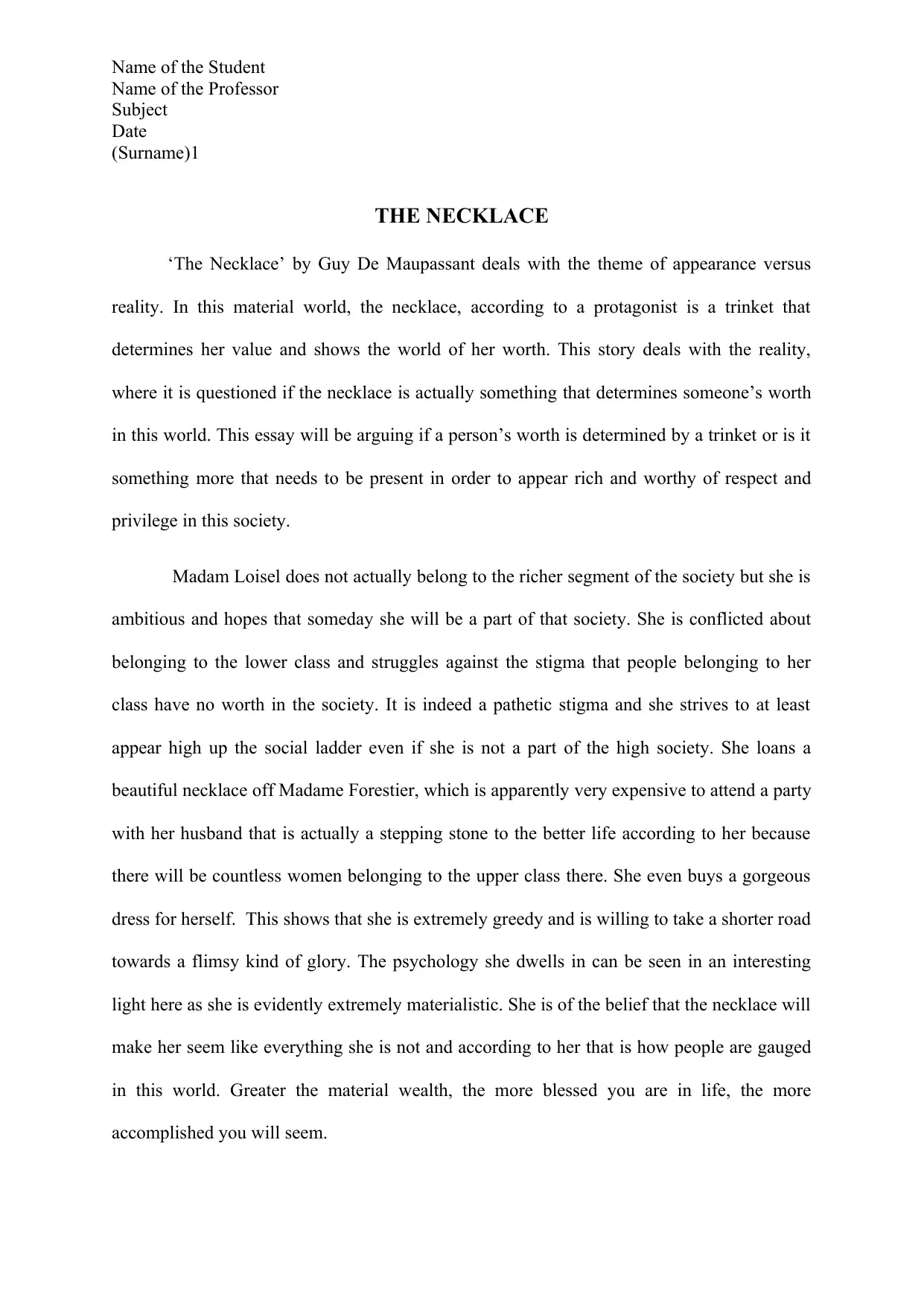
Name of the Student
Name of the Professor
Subject
Date
(Surname)1
THE NECKLACE
‘The Necklace’ by Guy De Maupassant deals with the theme of appearance versus
reality. In this material world, the necklace, according to a protagonist is a trinket that
determines her value and shows the world of her worth. This story deals with the reality,
where it is questioned if the necklace is actually something that determines someone’s worth
in this world. This essay will be arguing if a person’s worth is determined by a trinket or is it
something more that needs to be present in order to appear rich and worthy of respect and
privilege in this society.
Madam Loisel does not actually belong to the richer segment of the society but she is
ambitious and hopes that someday she will be a part of that society. She is conflicted about
belonging to the lower class and struggles against the stigma that people belonging to her
class have no worth in the society. It is indeed a pathetic stigma and she strives to at least
appear high up the social ladder even if she is not a part of the high society. She loans a
beautiful necklace off Madame Forestier, which is apparently very expensive to attend a party
with her husband that is actually a stepping stone to the better life according to her because
there will be countless women belonging to the upper class there. She even buys a gorgeous
dress for herself. This shows that she is extremely greedy and is willing to take a shorter road
towards a flimsy kind of glory. The psychology she dwells in can be seen in an interesting
light here as she is evidently extremely materialistic. She is of the belief that the necklace will
make her seem like everything she is not and according to her that is how people are gauged
in this world. Greater the material wealth, the more blessed you are in life, the more
accomplished you will seem.
Name of the Professor
Subject
Date
(Surname)1
THE NECKLACE
‘The Necklace’ by Guy De Maupassant deals with the theme of appearance versus
reality. In this material world, the necklace, according to a protagonist is a trinket that
determines her value and shows the world of her worth. This story deals with the reality,
where it is questioned if the necklace is actually something that determines someone’s worth
in this world. This essay will be arguing if a person’s worth is determined by a trinket or is it
something more that needs to be present in order to appear rich and worthy of respect and
privilege in this society.
Madam Loisel does not actually belong to the richer segment of the society but she is
ambitious and hopes that someday she will be a part of that society. She is conflicted about
belonging to the lower class and struggles against the stigma that people belonging to her
class have no worth in the society. It is indeed a pathetic stigma and she strives to at least
appear high up the social ladder even if she is not a part of the high society. She loans a
beautiful necklace off Madame Forestier, which is apparently very expensive to attend a party
with her husband that is actually a stepping stone to the better life according to her because
there will be countless women belonging to the upper class there. She even buys a gorgeous
dress for herself. This shows that she is extremely greedy and is willing to take a shorter road
towards a flimsy kind of glory. The psychology she dwells in can be seen in an interesting
light here as she is evidently extremely materialistic. She is of the belief that the necklace will
make her seem like everything she is not and according to her that is how people are gauged
in this world. Greater the material wealth, the more blessed you are in life, the more
accomplished you will seem.
Paraphrase This Document
Need a fresh take? Get an instant paraphrase of this document with our AI Paraphraser
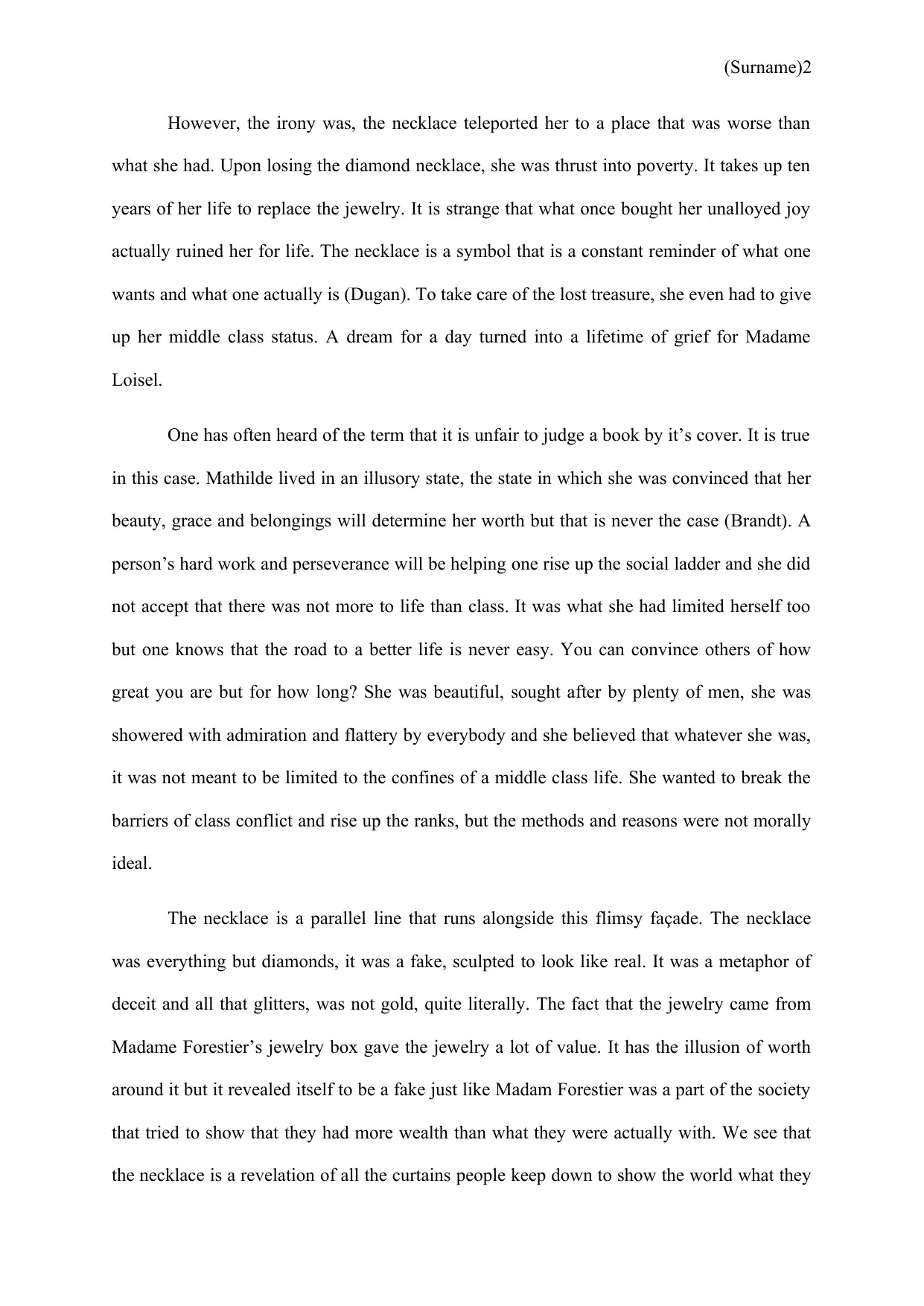
(Surname)2
However, the irony was, the necklace teleported her to a place that was worse than
what she had. Upon losing the diamond necklace, she was thrust into poverty. It takes up ten
years of her life to replace the jewelry. It is strange that what once bought her unalloyed joy
actually ruined her for life. The necklace is a symbol that is a constant reminder of what one
wants and what one actually is (Dugan). To take care of the lost treasure, she even had to give
up her middle class status. A dream for a day turned into a lifetime of grief for Madame
Loisel.
One has often heard of the term that it is unfair to judge a book by it’s cover. It is true
in this case. Mathilde lived in an illusory state, the state in which she was convinced that her
beauty, grace and belongings will determine her worth but that is never the case (Brandt). A
person’s hard work and perseverance will be helping one rise up the social ladder and she did
not accept that there was not more to life than class. It was what she had limited herself too
but one knows that the road to a better life is never easy. You can convince others of how
great you are but for how long? She was beautiful, sought after by plenty of men, she was
showered with admiration and flattery by everybody and she believed that whatever she was,
it was not meant to be limited to the confines of a middle class life. She wanted to break the
barriers of class conflict and rise up the ranks, but the methods and reasons were not morally
ideal.
The necklace is a parallel line that runs alongside this flimsy façade. The necklace
was everything but diamonds, it was a fake, sculpted to look like real. It was a metaphor of
deceit and all that glitters, was not gold, quite literally. The fact that the jewelry came from
Madame Forestier’s jewelry box gave the jewelry a lot of value. It has the illusion of worth
around it but it revealed itself to be a fake just like Madam Forestier was a part of the society
that tried to show that they had more wealth than what they were actually with. We see that
the necklace is a revelation of all the curtains people keep down to show the world what they
However, the irony was, the necklace teleported her to a place that was worse than
what she had. Upon losing the diamond necklace, she was thrust into poverty. It takes up ten
years of her life to replace the jewelry. It is strange that what once bought her unalloyed joy
actually ruined her for life. The necklace is a symbol that is a constant reminder of what one
wants and what one actually is (Dugan). To take care of the lost treasure, she even had to give
up her middle class status. A dream for a day turned into a lifetime of grief for Madame
Loisel.
One has often heard of the term that it is unfair to judge a book by it’s cover. It is true
in this case. Mathilde lived in an illusory state, the state in which she was convinced that her
beauty, grace and belongings will determine her worth but that is never the case (Brandt). A
person’s hard work and perseverance will be helping one rise up the social ladder and she did
not accept that there was not more to life than class. It was what she had limited herself too
but one knows that the road to a better life is never easy. You can convince others of how
great you are but for how long? She was beautiful, sought after by plenty of men, she was
showered with admiration and flattery by everybody and she believed that whatever she was,
it was not meant to be limited to the confines of a middle class life. She wanted to break the
barriers of class conflict and rise up the ranks, but the methods and reasons were not morally
ideal.
The necklace is a parallel line that runs alongside this flimsy façade. The necklace
was everything but diamonds, it was a fake, sculpted to look like real. It was a metaphor of
deceit and all that glitters, was not gold, quite literally. The fact that the jewelry came from
Madame Forestier’s jewelry box gave the jewelry a lot of value. It has the illusion of worth
around it but it revealed itself to be a fake just like Madam Forestier was a part of the society
that tried to show that they had more wealth than what they were actually with. We see that
the necklace is a revelation of all the curtains people keep down to show the world what they
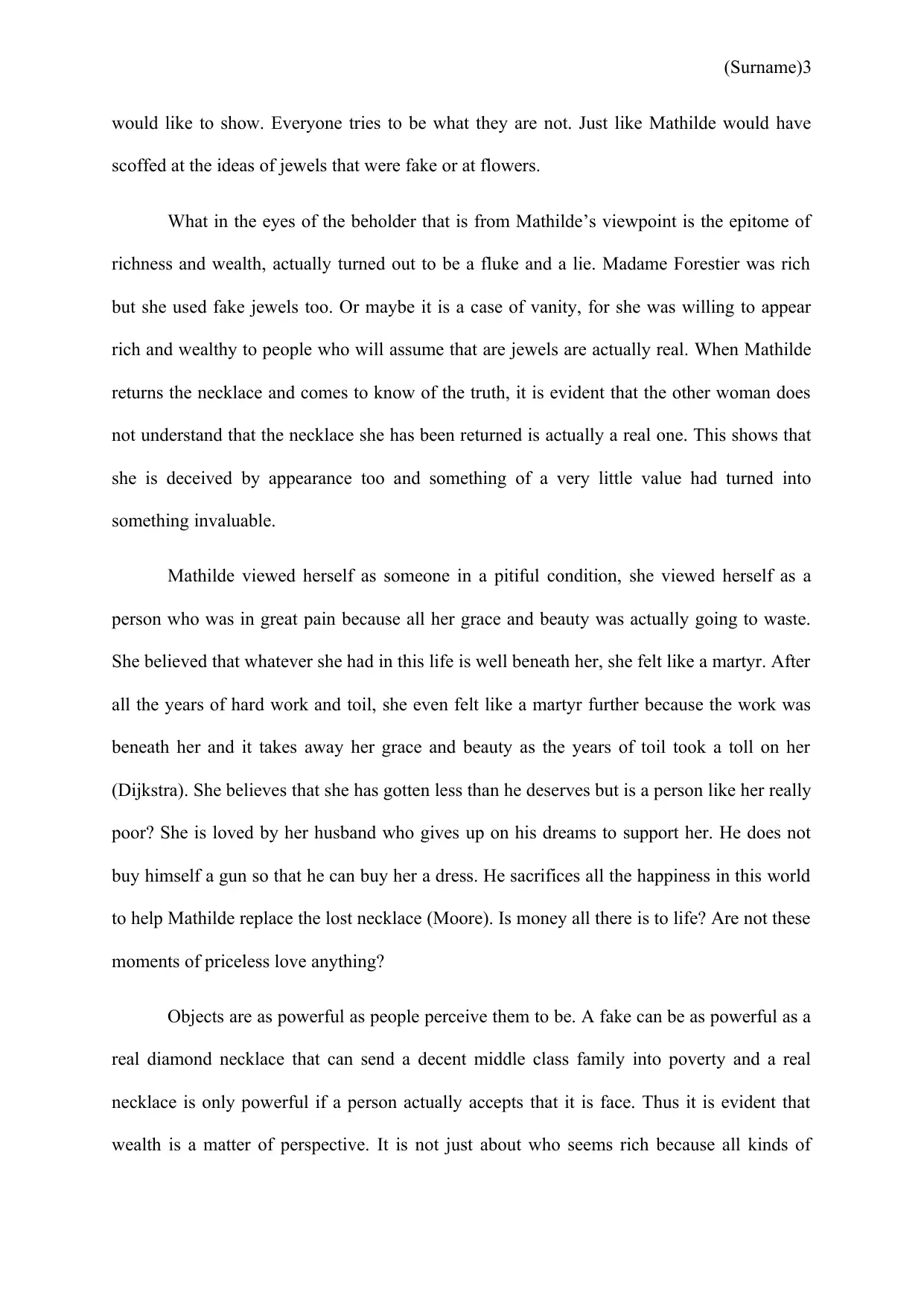
(Surname)3
would like to show. Everyone tries to be what they are not. Just like Mathilde would have
scoffed at the ideas of jewels that were fake or at flowers.
What in the eyes of the beholder that is from Mathilde’s viewpoint is the epitome of
richness and wealth, actually turned out to be a fluke and a lie. Madame Forestier was rich
but she used fake jewels too. Or maybe it is a case of vanity, for she was willing to appear
rich and wealthy to people who will assume that are jewels are actually real. When Mathilde
returns the necklace and comes to know of the truth, it is evident that the other woman does
not understand that the necklace she has been returned is actually a real one. This shows that
she is deceived by appearance too and something of a very little value had turned into
something invaluable.
Mathilde viewed herself as someone in a pitiful condition, she viewed herself as a
person who was in great pain because all her grace and beauty was actually going to waste.
She believed that whatever she had in this life is well beneath her, she felt like a martyr. After
all the years of hard work and toil, she even felt like a martyr further because the work was
beneath her and it takes away her grace and beauty as the years of toil took a toll on her
(Dijkstra). She believes that she has gotten less than he deserves but is a person like her really
poor? She is loved by her husband who gives up on his dreams to support her. He does not
buy himself a gun so that he can buy her a dress. He sacrifices all the happiness in this world
to help Mathilde replace the lost necklace (Moore). Is money all there is to life? Are not these
moments of priceless love anything?
Objects are as powerful as people perceive them to be. A fake can be as powerful as a
real diamond necklace that can send a decent middle class family into poverty and a real
necklace is only powerful if a person actually accepts that it is face. Thus it is evident that
wealth is a matter of perspective. It is not just about who seems rich because all kinds of
would like to show. Everyone tries to be what they are not. Just like Mathilde would have
scoffed at the ideas of jewels that were fake or at flowers.
What in the eyes of the beholder that is from Mathilde’s viewpoint is the epitome of
richness and wealth, actually turned out to be a fluke and a lie. Madame Forestier was rich
but she used fake jewels too. Or maybe it is a case of vanity, for she was willing to appear
rich and wealthy to people who will assume that are jewels are actually real. When Mathilde
returns the necklace and comes to know of the truth, it is evident that the other woman does
not understand that the necklace she has been returned is actually a real one. This shows that
she is deceived by appearance too and something of a very little value had turned into
something invaluable.
Mathilde viewed herself as someone in a pitiful condition, she viewed herself as a
person who was in great pain because all her grace and beauty was actually going to waste.
She believed that whatever she had in this life is well beneath her, she felt like a martyr. After
all the years of hard work and toil, she even felt like a martyr further because the work was
beneath her and it takes away her grace and beauty as the years of toil took a toll on her
(Dijkstra). She believes that she has gotten less than he deserves but is a person like her really
poor? She is loved by her husband who gives up on his dreams to support her. He does not
buy himself a gun so that he can buy her a dress. He sacrifices all the happiness in this world
to help Mathilde replace the lost necklace (Moore). Is money all there is to life? Are not these
moments of priceless love anything?
Objects are as powerful as people perceive them to be. A fake can be as powerful as a
real diamond necklace that can send a decent middle class family into poverty and a real
necklace is only powerful if a person actually accepts that it is face. Thus it is evident that
wealth is a matter of perspective. It is not just about who seems rich because all kinds of
⊘ This is a preview!⊘
Do you want full access?
Subscribe today to unlock all pages.

Trusted by 1+ million students worldwide
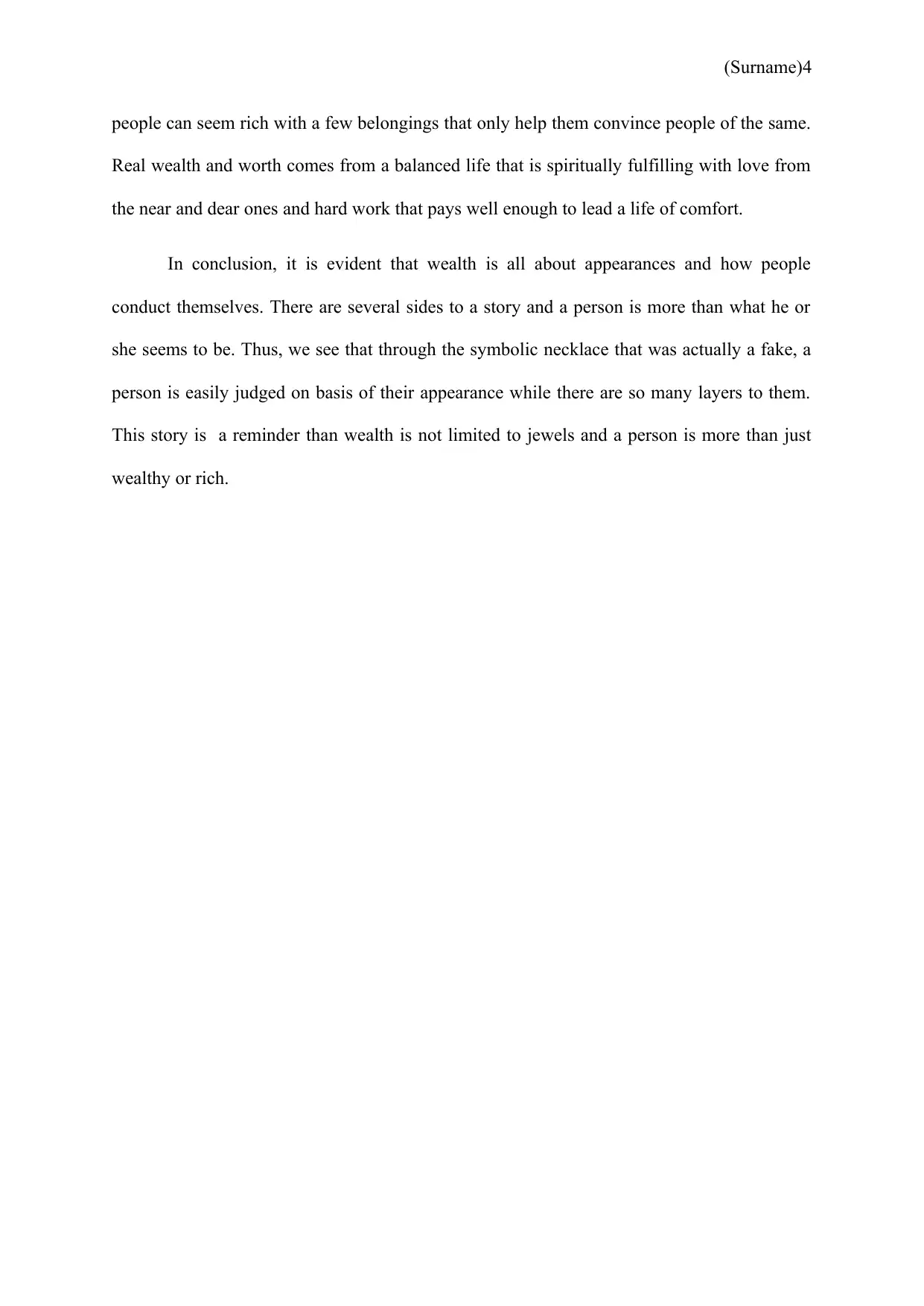
(Surname)4
people can seem rich with a few belongings that only help them convince people of the same.
Real wealth and worth comes from a balanced life that is spiritually fulfilling with love from
the near and dear ones and hard work that pays well enough to lead a life of comfort.
In conclusion, it is evident that wealth is all about appearances and how people
conduct themselves. There are several sides to a story and a person is more than what he or
she seems to be. Thus, we see that through the symbolic necklace that was actually a fake, a
person is easily judged on basis of their appearance while there are so many layers to them.
This story is a reminder than wealth is not limited to jewels and a person is more than just
wealthy or rich.
people can seem rich with a few belongings that only help them convince people of the same.
Real wealth and worth comes from a balanced life that is spiritually fulfilling with love from
the near and dear ones and hard work that pays well enough to lead a life of comfort.
In conclusion, it is evident that wealth is all about appearances and how people
conduct themselves. There are several sides to a story and a person is more than what he or
she seems to be. Thus, we see that through the symbolic necklace that was actually a fake, a
person is easily judged on basis of their appearance while there are so many layers to them.
This story is a reminder than wealth is not limited to jewels and a person is more than just
wealthy or rich.
Paraphrase This Document
Need a fresh take? Get an instant paraphrase of this document with our AI Paraphraser
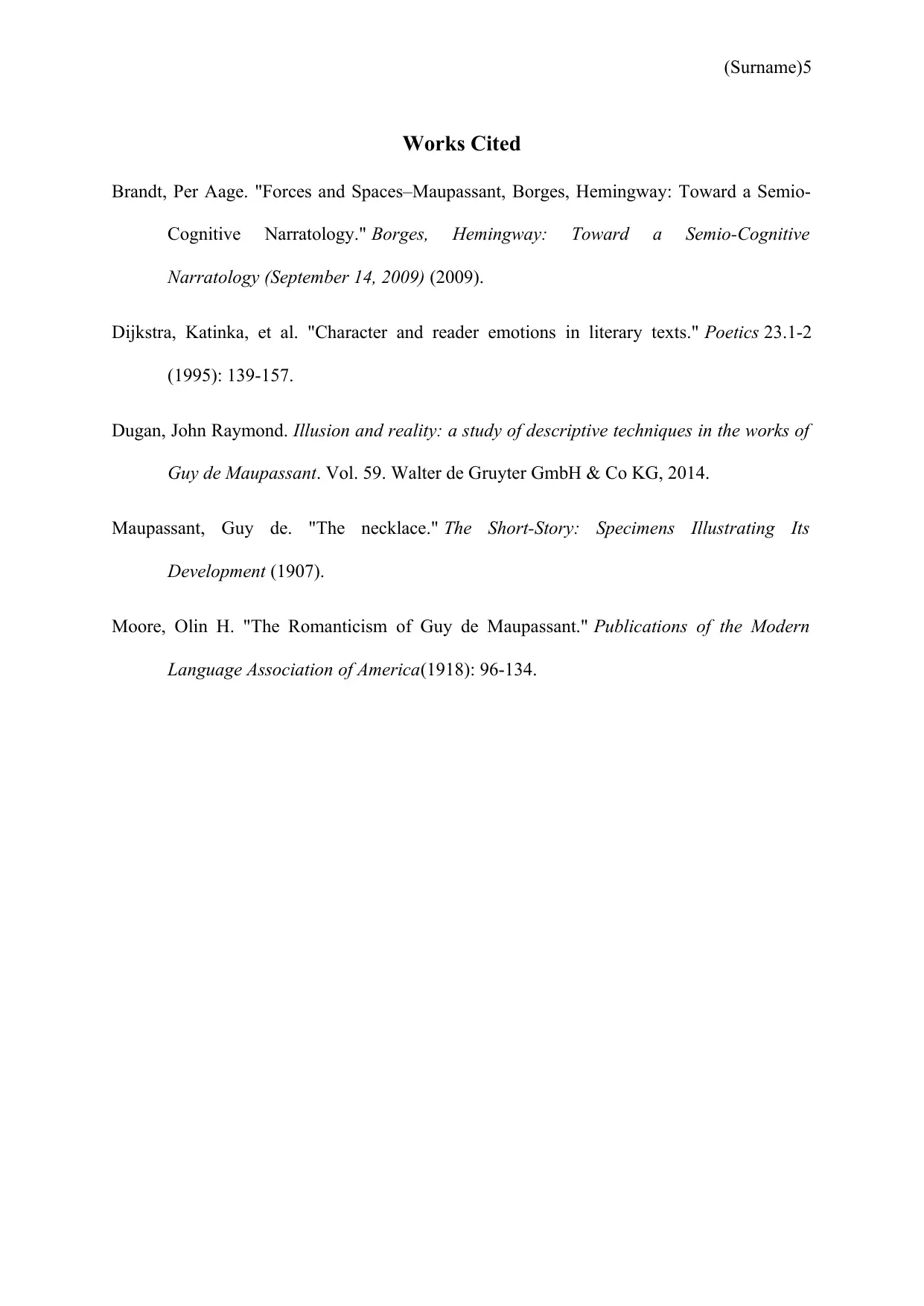
(Surname)5
Works Cited
Brandt, Per Aage. "Forces and Spaces–Maupassant, Borges, Hemingway: Toward a Semio-
Cognitive Narratology." Borges, Hemingway: Toward a Semio-Cognitive
Narratology (September 14, 2009) (2009).
Dijkstra, Katinka, et al. "Character and reader emotions in literary texts." Poetics 23.1-2
(1995): 139-157.
Dugan, John Raymond. Illusion and reality: a study of descriptive techniques in the works of
Guy de Maupassant. Vol. 59. Walter de Gruyter GmbH & Co KG, 2014.
Maupassant, Guy de. "The necklace." The Short-Story: Specimens Illustrating Its
Development (1907).
Moore, Olin H. "The Romanticism of Guy de Maupassant." Publications of the Modern
Language Association of America(1918): 96-134.
Works Cited
Brandt, Per Aage. "Forces and Spaces–Maupassant, Borges, Hemingway: Toward a Semio-
Cognitive Narratology." Borges, Hemingway: Toward a Semio-Cognitive
Narratology (September 14, 2009) (2009).
Dijkstra, Katinka, et al. "Character and reader emotions in literary texts." Poetics 23.1-2
(1995): 139-157.
Dugan, John Raymond. Illusion and reality: a study of descriptive techniques in the works of
Guy de Maupassant. Vol. 59. Walter de Gruyter GmbH & Co KG, 2014.
Maupassant, Guy de. "The necklace." The Short-Story: Specimens Illustrating Its
Development (1907).
Moore, Olin H. "The Romanticism of Guy de Maupassant." Publications of the Modern
Language Association of America(1918): 96-134.
1 out of 5
Your All-in-One AI-Powered Toolkit for Academic Success.
+13062052269
info@desklib.com
Available 24*7 on WhatsApp / Email
![[object Object]](/_next/static/media/star-bottom.7253800d.svg)
Unlock your academic potential
Copyright © 2020–2025 A2Z Services. All Rights Reserved. Developed and managed by ZUCOL.


